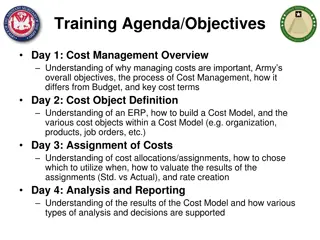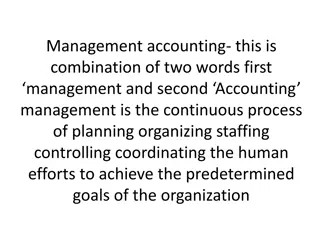
Societal Obligations of Accounting in Evaluating Social Cost Benefits
The concept of social cost benefits emphasizes considering both commercial viability and societal impacts when undertaking projects. Evaluation criteria should not be solely profit-based but also include social costs and benefits. This approach ensures projects contribute positively to society and are not just profitable for the firm.
Download Presentation

Please find below an Image/Link to download the presentation.
The content on the website is provided AS IS for your information and personal use only. It may not be sold, licensed, or shared on other websites without obtaining consent from the author. If you encounter any issues during the download, it is possible that the publisher has removed the file from their server.
You are allowed to download the files provided on this website for personal or commercial use, subject to the condition that they are used lawfully. All files are the property of their respective owners.
The content on the website is provided AS IS for your information and personal use only. It may not be sold, licensed, or shared on other websites without obtaining consent from the author.
E N D
Presentation Transcript
CLASS : BBA CLASS : BBA- -I ( II SEMESTER) I ( II SEMESTER) SUBJECT : ANALYSIS OF FINANCIAL STATEMENTS SUBJECT : ANALYSIS OF FINANCIAL STATEMENTS TOPIC : SOCIETAL OBLIGATIONS OF ACCOUNTING TOPIC : SOCIETAL OBLIGATIONS OF ACCOUNTING PREPARED BY PREPARED BY MS. KARUNA SACHDEVA MS. KARUNA SACHDEVA (ASSISTANT PROFESSOR) (ASSISTANT PROFESSOR) DEPARTMENT OF COMMERCE AND MANAGEMENT DEPARTMENT OF COMMERCE AND MANAGEMENT I.B. (PG) COLLEGE , PANIPAT I.B. (PG) COLLEGE , PANIPAT (AFFILIATED TO KURUKSHETRA (AFFILIATED TO KURUKSHETRA UNIVERSITY, KURUKSHETRA) UNIVERSITY, KURUKSHETRA)
CONCEPT OF SOCIAL COST BENEFITS The concept of social cost benefits means that while undertaking a project , the firm must also consider its social costs and benefits to the society alongwith its commercial viability. No project should be undertaken which will result in heavy social cost to the society and yield little benefits to the society ,even if it may be commercially profitable project. Thus, evaluation of the project cannot be done on profit criteria and it should be done on the basis of social cost and benefit associated with the project.
FOR EXAMPLE If an industrial unit to manufacture textiles is to be set up in a city ,then the industry will pay for resources such as capital , labour , etc. and will consider cost of all these resources but it will not consider smoke, release of injurious gases and pollution to environment . Therefore, The residents will pay social costs in form of poor health, spread of diseases ,etc. They will also get social benefits in the form of employment opportunities , saving of foreign exchange ,etc. Thus, social cost and social benefits must be considered while evaluating a project
CONTINUED. Thus, Social cost benefit analysis is the evaluation of a project on the basis of net impact on the economy . A project whose total benefits ( economic and social ) are greater than its total cost ( economic and social ) , then it is to be accepted only otherwise it must be rejected.
INDICATORS FOR MEASURING THE SOCIAL COSTS AND BENEFITS EMPLOYMENT POTENTIAL : A project which is labour intensive will have higher employment potential and it must be preferred as compared to project having a lower employment potential . CAPITAL OUTPUT RATIO : The project which gives higher output per unit of capital employed must be preferred as compared to the project having lower output per unit of capital employed . VALUE ADDED CRITERION : Value added indicates the cost incurred by an enterprises in converting raw material into finished output and it includes salaries , rent ,wages, etc. Under this criterion , the project which gives higher value added must be preferred as compared to the project which gives lower value added .
CONTINUED. SAVING IN FOREIGN EXCHANGE : The projects which have higher potentiality of foreign exchange must be preferred as compared to other projects which do not result in increasing foreign exchange reserves of the country . COST BENEFIT RATIO : All the projects must be ranked according to their cost benefit ratio and the project having higher cost benefit ratio must be preferred as compared to the project having lower cost benefit ratio .
SOCIAL ACCOUNTING The National Association of Accountants (NAA) Committee defined social accounting as the identification, measurement, monitoring and reporting of the social and economic effects of an institution on society . Thus, social accounting is concerned with the internal and external reporting of social costs and benefits both in quantitative as well as qualitative terms by a business enterprise . Social Accounting is also known as Social Responsibility Accounting, Socio-Economic Accounting, Social Reporting and Social Audit which aims to measure and inform the general public about the social welfare activities undertaken by the enterprise and their effects on the society .
FEATURES OF SOCIAL ACCOUNTING Social accounting is related to the use of social resources. Social accounting mainly concentrates on relationship between firm and society. Social accounting tells us about desirability of the firm in society. Social accounting also concentrates on social costs. Social accounting is concerned with the application of accounting on social sciences. Social accounting is an expression of a company s social responsibilities.
NEED OR BENEFITS OF SOCIAL ACCOUNTING Social accounting makes a firm to fulfill its social obligations . Social accounting is necessary from the view point of public interest groups, social organisations , investors and government. It guides management in formulating appropriate policies and programmes. It improves the image of the firm. With the help of social accounting , the firm proves that it is not socially unethical in view of moral cultures and environmental degradation. It helps in marketing through greater customer support.
SCOPE OF SOCIAL ACCOUNTING HUMAN RESOURCE CONTRIBUTIONS: This contribution reflects impact of enterprises policies on human resources . It includes well being of the employees such as training programmes , job enrichment ,etc. ENVIRONMENTAL CONTRIBUTIONS : It includes activities relating to environmental deterioration through air, water and noise pollution ,etc. PRODUCT AND SERVICE CONTRIBUTIONS : It deals with the impact of firm s product or service on the society such as product quality , packaging , advertising ,etc.
SOCIAL ACCOUNTING APPROACHES DESCRIPTIVE APPROACH: According to this method , the social activities of business corporations are presented along-with financial statements in narrative form and not in quantitative form. PICTORIAL APPROACH : Under this approach, photographs of health care center, schools and hospitals run by the company are presented in annual reports. OPERATING STATEMENT APPROACH : Under it , the positive aspects are called social benefits and negative aspects are called social costs and these are presented by the firm. The difference between the social benefits and social costs are termed as net social contribution. INTEGRAL WELFARE THEORETICAL APPROACH : This approach advocates the preparation of a social report comprising social benefits and social costs.






















